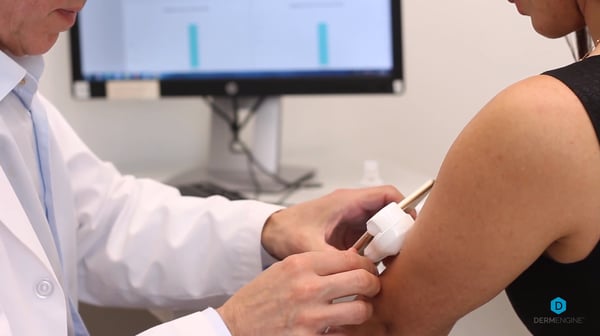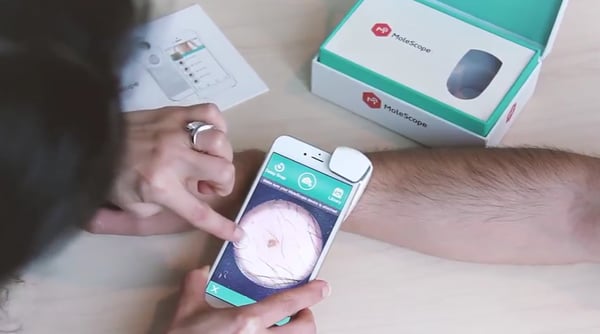What Features Are Dermatologists Looking For In Their Dermatoscope?
Dermoscopy is a common practice in dermatology services, as magnified skin imaging proves to increase diagnostic accuracy and reduce unnecessary biopsies.1,2 However, before a dermatologist can begin utilizing a dermoscope, he must determine which technical characteristics will best suit his imaging needs. This article will present an overview of the current status of dermoscopy while comparing features of mobile dermoscopes.
Traditionally, dermatology services have been physical observation of skin lesions with diagnostic results being based off what the naked-eye could see. However, affected by inherent human limitations, this approach is rendered inefficient for complex cases.
The need for clearer skin images coupled with technical advances in magnification and image-capturing procedures have made dermoscopy the preferred non-invasive technique to the diagnosis of skin conditions such as melanoma.3 Having access to a more detailed observation of the lesion in study, dermatologists can base their clinical decisions on more solid grounds. The efficacy in the application of dermoscopy has shown an increase of about 35% in the accuracy of diagnosis.4
2. Current features in mobile dermoscopes
- Mobile device compatibility: recently, mobile dermoscopes have been designed to be used in synergy with smartphones and tablets. Their overwhelming prevalence combined with the increasing camera quality make them the perfect partner for mobile dermoscopy. The mobile nature of dermoscopes implies the utilization of a smart device’s camera, making all brands compatible for such a feature. Yet, only a few are able to adjust to a wide range of devices. MetaOptima’s MoleScope II is equipped with rubber attachments that allow to fit it in all common Android and iPhone smartphones and tablets.
- Magnification: the very nature of a dermoscopic analysis is based on a magnified view of a high quality image, making this a crucial step for dermatology-related diagnosis, particularly those relating to the early detection of skin cancer. Generally, the vast majority of dermoscopes have magnification ranging between 10X to 40X. However, it is fair to say that the magnification of mobile dermoscopes heavily relies on the quality of the phone’s camera. For example, MoleScope II device boasts increased magnification to ~60X or more depending on the smartphone utilized.
- Light source: proper illumination greatly affects the quality of dermoscopic imaging. A wide range of mobile devices, including MoleScope II, offer cross-polarized light functionalities. This allows for deeper skin level imaging capability, bringing the advantage to easily identify malignant structures.5 Additionally, the use of polarized light allows for direct skin-contact imaging, eliminating the need for a liquid interface and simplifying this everyday procedure.
- Affordability: price can play a key role in deciding which device is most appropriate for a practice. Given the complexity in packing cutting-edge technology in a hand-held device, the wide majority of dermoscopes tend to be pricey. However, at $399 (USD) MoleScope II stands out as a remarkable less expensive option with a high price/quality ratio in contrast to others in the low-price range currently available in the market.
- Mobile app availability: one of the most useful features present in dermoscope devices is their connection to smartphone apps. Streamlining workflows with smart tools from dedicated software can greatly increase the quality of the analyses performed with dermoscope devices. There is a higher trend currently showing more manufacturers choose to complement devices with mobile applications.6 Such is the case for MoleScope II and its dedicated DermEngine app that offers imaging, documentation and teledermatology capabilities and can be synced with the web platform for improved workflows.
Conclusion
As dermoscopy continues to unfold new advances to help doctors and patients alike, mobility and portability have been paradigm breakers in the last few years allowing for an increased availability higher quality devices in the market. As a result, dermoscopy is no longer location-dependent, with complementing intelligent dermatology software enabling more precise diagnostic analysis. Together, these changes and the ones underway continue the improvements in the field that are helping professionals effectivize their practice and patients receive life-saving care.
-The MetaOptima Team
Would like to benefit from the latest advances in dermoscopy? MoleScope II offers you all the features you need for your daily dermatology practice. Order it now!
1-https://wiki.cancer.org.au/australia/
2-https://www.ncbi.nlm.nih.gov/
3-https://www.ncbi.nlm.nih.gov/
4-https://www.dermnetnz.org/
5-https://jamanetwork.com/
6-https://www.ncbi.nlm.nih.gov/
Topics: Dermoscopy MoleScope Digital Dermatoscopes Digital Dermoscopy Dermoscope Dermatoscope Dermatoscopy Mobile Dermoscope Mobile Dermoscopy







